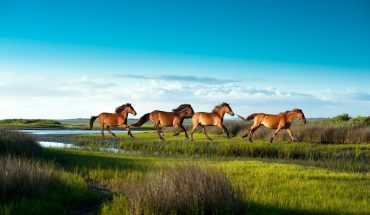by Liza Roberts
photographs by Nick Pironio
Down a pebbly road, in a wood-framed studio in a rural corner of Garner, wildlife artist Duane Raver is perfecting a swan. Its wings stretch across his canvas, feathers precise in number, formation, and color. The brush he uses to define them is tiny, and so are the bits of acrylic paint he dabs from the dented palette he’s made out of an old cardboard box.
Wild creatures with glassy eyes watch him work. Bears, ducks, fish, deer, buffalo, zebra. A giraffe. They are the work of Raver’s daughter, noted taxidermist Diane Raver Braswell, whose career was inspired by her father’s work, and now inspires his own.
The swan taking shape before Raver, 88, displays the skill that has made him one of the most successful and beloved southern wildlife artists of his time. His meticulous and beautiful illustrations have graced hundreds of magazine covers, including more than 200 for Wildlife in North Carolina, a magazine the former fishery biologist managed and then edited from 1960 – 1979. His depictions are so accurate that they also fill reference books like Fisherman’s Guide: Fishes of the Southeastern United States. But it’s his love of the wildlife he paints in their native habitats that elevates his work to another level. He has been the N.C. Wildlife Federation’s Wildlife Artist of the Year four times and has collected too many other awards to mention, including The Order of the Long Leaf Pine, one of the state’s highest honors.
“I admire him very much,” says Bob Timberlake, the famous North Carolina wildlife artist and home furnishings designer. “He’s almost like a mentor to me. I admire his giving ways, and his ability as an artist. He’s humble, and truly gifted.”
Kudos and honors are not in much evidence in the modest, cedar-smelling studio Raver shares with his daughter. Like his homemade palette, his surroundings are simple, purposeful, well-worn. Inspiration takes the form of his daughter’s menagerie, work by fellow artists, and a glimpse of the outdoors through ample windows. The wooded acreage that forms the Raver family compound – he and his wife Mary live beside their two grown daughters and their families (their son lives in Apex) – is teeming with wildlife. Deer and screech owls, hawks and songbirds live here; others make regular visits. Outside, down a short hill from the terraced gardens Raver tends, Swift Creek makes its windy journey south to join the Neuse River before eventually meeting up with the Pamlico Sound.
The swan that Raver’s working on flies in a sky not far from where that creek is headed. It swoops above Lake Mattamuskeet, on the Albemarle-Pamlico Peninsula. Like almost all of Raver’s work these days, the painting has a particular purpose. He’s making it for (and donating it to) the U.S. Fish and Wildlife Service, which will use it to commemorate Swan Days. The annual early December event celebrates the return of tundra swans and other wildlife to North Carolina’s largest natural lake. Raver’s painting will be auctioned Dec. 5 to benefit the Mattamuskeet National Wildlife Refuge, and will be reproduced with limited-edition prints and on T-shirts. But not before Raver gets it just right.
Not that there’s any danger of another outcome, as his reputation attests. “It’s not just that the details are very accurate,” says Pete Campbell, who manages the refuge, reveres Raver’s work, and has come to know him from the artist’s regular visits to the lake to watch the wildlife. “There’s a warmth and a feeling of familiarity” to Raver’s work that lovers of the outdoors particularly appreciate, Campbell says. “It’s a tough balance. You can be very accurate and create textbook-quality paintings, but it’s got to have a presence to it. His artwork exudes that time and place he’s trying to capture.”
That magical quality, in part, is what inspired his daughter Diane to become one of a handful of women taxidermists in the state. “I was exposed to watching him paint from early on, and the subject of wildlife kind of stuck with me,” she says. So did a love of animals, which her father also helped spark with regular weekend visits to Raleigh’s North Carolina Museum of Natural Sciences, where he took her behind the scenes and showed her the animals, live and preserved.
Tireless, timeless
“It’s been an interesting few months,” Raver says on a recent fall morning. He’s been particularly busy: preparing for the N.C. State Fair, where he will paint and meet the public for several days, as he has every year for 35 years; signing calendars at his friend Bob Timberlake’s gallery; being interviewed by journalists who want to tell his story.
Raver’s low-tech, straightforward surroundings – a small, ancient radio; the no-nonsense plastic boxes and filing cabinets that form his archives; the to-do reminders masking-taped to his easel; a monthly pictorial wildlife calendar for keeping appointments – are timeless, and somehow also outside of time, like his art itself.
Raver is a North Carolinian by choice. Born in Newton, Iowa, in 1927, Raver arrived in 1950 to take a job as a fishery biologist with the state Wildlife Resources Commission and never left. He’s been drawing and painting his entire life. At a very young age, earlier even than kindergarten, “I discovered that I had a God-given talent.” And an obvious subject: the natural world.
“I don’t remember when I didn’t love the outdoors,” he says, and the creatures in it. “Fish, birds, everything.”
The first fish Raver ever painted, a black crappie, was one he’d just caught near a friend’s cabin at Bad Axe Lake, Minnesota. It hadn’t been out of the water an hour when “I flopped that fish up on the kitchen table in the cabin,” he says, and painted it with watercolors he carried “in a little tin box.” He was 16.
Today, Raver’s hands pull that very black crappie painting out of the filing cabinet beside his easel. On a page ripped from a drawing pad, the 71-year-old watercolor is as fresh and vibrant as if it were just made. There are more watercolors from those early years: a 1949 walleye, caught in Spirit Lake, Iowa. A 1946 white crappie from Spring Lake, Iowa, which for the first time he laid on the page and carefully traced before painting. “It ended up in the frying pan after that, I’m sure,” he says. It was only later that Raver learned – thanks to his precise tracing – that the fish was actually one of the largest white crappies ever caught in the state.
He does have a knack with fish, which are his first love. Today he paints them mostly on wooden boat paddles that a carpenter friend makes. He sells them on commission; He’s preparing a few to bring to the Fair, too, but knows they’ll be gone within a few hours.
Raver smiles when asked to describe his work. “I don’t consider myself necessarily an artist,” he says, “so much as an illustrator.” His steady work for decades and regular honors mostly reflect industriousness, he suggests. “I wasn’t all that great, but I was available.” Ask him about his training, and he’ll throw his head back and laugh. A six-week painting course as a high-schooler, during which he painted an orange and a banana, represents the sum total of his artistic schooling. Since then, it’s been “a seat-of-the-pants, trial-and-error, hope-for-the-best kind of thing,” he says.
He says the finer points command his focus: His work is “as detailed as I can make it,” he says, “As close to the actual critter as I can … Count the feathers,” he says of his bird paintings. “They’re right.” Fish: “Count the scales: They’re correct.” He pulls out the 1984 Fisherman’s Guide: Fishes of the Southeastern United States, which is so precise it was used by the University of Tennessee as a fish identification textbook.
Despite this precision, Raver says he’s never completely happy with his work. “I’ve never done a painting I was totally satisfied with,” he says. “There are several things I wish I could do differently. I’ve tried to improve them to be more exact, particularly when they’re for publication.”
Sometimes his daughter’s animals provide the models for his work; sometimes he goes into the N.C. State archives for preserved fish specimens, which are helpful for accurately depicting scales, but not for color. For that, he relies on scientists’ notes, and his own.
For the swan on the canvas before him, Raver’s got photographs, preserved specimen on the walls around him, and his own detailed knowledge. He dabs the canvas, but thinks he ought to stop. “There comes a time,” he says, “and I’ve learned this, when you’ve got to leave good enough alone.” He scans the painting, assessing. “I try the best I know how.”









